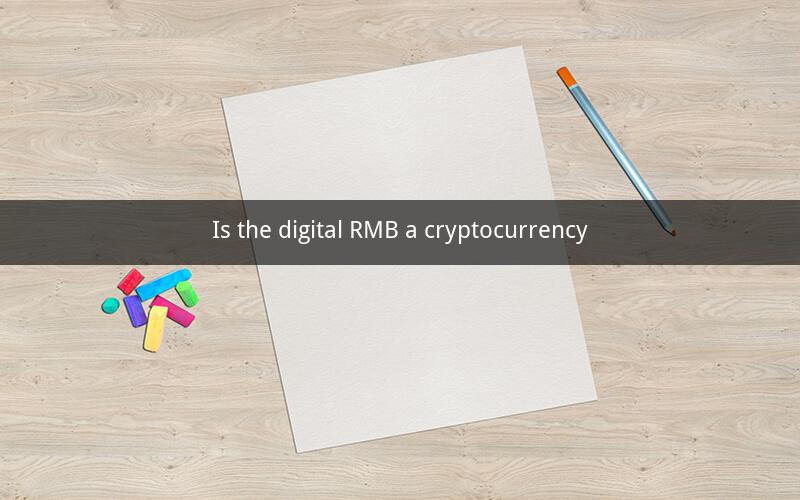
Table of Contents
1. Introduction to Digital RMB
2. Understanding Cryptocurrency
3. Comparing Digital RMB and Cryptocurrency
- Similarities
- Differences
4. The Legal and Regulatory Landscape
- China's Approach
- Global Perspective
5. The Potential Impact of Digital RMB
- Economic Benefits
- Security Concerns
6. Public Perception and Adoption
7. Conclusion
1. Introduction to Digital RMB
The digital RMB, also known as the electronic currency, is a digital form of the Chinese yuan that was launched by the People's Bank of China (PBOC) in 2019. It is designed to be a digital version of the physical currency and operates within the existing banking system. The primary goal of the digital RMB is to facilitate transactions, improve efficiency, and enhance the overall payment experience.
2. Understanding Cryptocurrency
Cryptocurrency is a digital or virtual currency that uses cryptography to secure transactions and to control the creation of new units. Unlike traditional currencies, cryptocurrencies operate independently of any central authority and are typically based on blockchain technology. The most well-known cryptocurrency is Bitcoin, which was launched in 2009.
3. Comparing Digital RMB and Cryptocurrency
Similarities
Both digital RMB and cryptocurrencies are digital forms of money, and they both aim to facilitate transactions. They both use technology to secure transactions and manage the supply of the currency.
Differences
Despite their similarities, there are significant differences between digital RMB and cryptocurrencies.
- Centralized vs. Decentralized: Digital RMB is a centralized currency, meaning that the PBOC has control over its issuance and management. Cryptocurrencies, on the other hand, are decentralized and operate independently of any central authority.
- Regulation: Digital RMB is regulated by the PBOC and is subject to the same laws and regulations that govern the physical currency. Cryptocurrencies, on the other hand, are often unregulated or subject to varying regulations depending on the country.
- Security: Digital RMB is considered to be more secure than cryptocurrencies because it is backed by the government and operates within the existing banking system. Cryptocurrencies, while secure through blockchain technology, are subject to market volatility and potential security breaches.
4. The Legal and Regulatory Landscape
China's Approach
China has been a pioneer in the development of digital currencies. The PBOC has been working on the digital RMB for several years and has made significant progress in its development. China's approach to digital RMB is to integrate it with the existing banking system and ensure its stability and security.
Global Perspective
The global perspective on digital RMB and cryptocurrencies is mixed. While some countries are exploring the use of digital currencies, others are cautious or outright opposed to their use. The global financial community is closely watching China's approach to digital RMB and its potential impact on the global financial system.
5. The Potential Impact of Digital RMB
Economic Benefits
The digital RMB has the potential to bring several economic benefits, including:
- Increased Efficiency: Digital RMB can streamline transactions and reduce the need for cash, which can save time and resources.
- Reduced Counterfeiting: The digital RMB is more difficult to counterfeit than physical currency.
- Enhanced Financial Inclusion: Digital RMB can provide access to financial services for people who do not have access to traditional banking.
Security Concerns
Despite its potential benefits, the digital RMB also raises security concerns, including:
- Privacy: The digital RMB may allow the government to monitor transactions more closely, raising privacy concerns.
- Cybersecurity: The digital RMB could be vulnerable to cyber attacks, which could compromise the financial system.
6. Public Perception and Adoption
The public perception and adoption of the digital RMB are still evolving. While some people are excited about the potential benefits of the digital RMB, others are concerned about its potential risks. The pace of adoption will depend on the effectiveness of the PBOC's marketing and educational efforts.
7. Conclusion
The digital RMB is a significant development in the world of digital currencies. While it shares some similarities with cryptocurrencies, it also has distinct differences. The digital RMB has the potential to bring significant economic benefits, but it also raises important security concerns. The future of the digital RMB will depend on the PBOC's ability to manage these challenges and promote its adoption.
Questions and Answers
1. What is the main difference between digital RMB and cryptocurrencies?
- Digital RMB is a centralized currency regulated by the PBOC, while cryptocurrencies are decentralized and often unregulated.
2. What are the potential economic benefits of the digital RMB?
- The digital RMB can increase efficiency, reduce counterfeiting, and enhance financial inclusion.
3. What are the main security concerns related to the digital RMB?
- The digital RMB raises concerns about privacy and cybersecurity.
4. How is the digital RMB different from physical currency?
- The digital RMB is a digital form of the yuan that operates within the existing banking system, while physical currency is tangible money.
5. What is the role of the PBOC in the digital RMB?
- The PBOC is responsible for the issuance and management of the digital RMB.
6. How does the digital RMB compare to Bitcoin?
- The digital RMB is a centralized currency regulated by the government, while Bitcoin is a decentralized cryptocurrency.
7. What are the legal and regulatory challenges facing the digital RMB?
- The digital RMB faces legal and regulatory challenges related to privacy, cybersecurity, and integration with the existing financial system.
8. How is the public perception of the digital RMB?
- The public perception of the digital RMB is still evolving, with some excitement about its potential benefits and others expressing concerns about its risks.
9. What is the pace of adoption for the digital RMB?
- The pace of adoption for the digital RMB will depend on the effectiveness of the PBOC's marketing and educational efforts.
10. What is the future of the digital RMB?
- The future of the digital RMB will depend on the PBOC's ability to manage its challenges and promote its adoption.